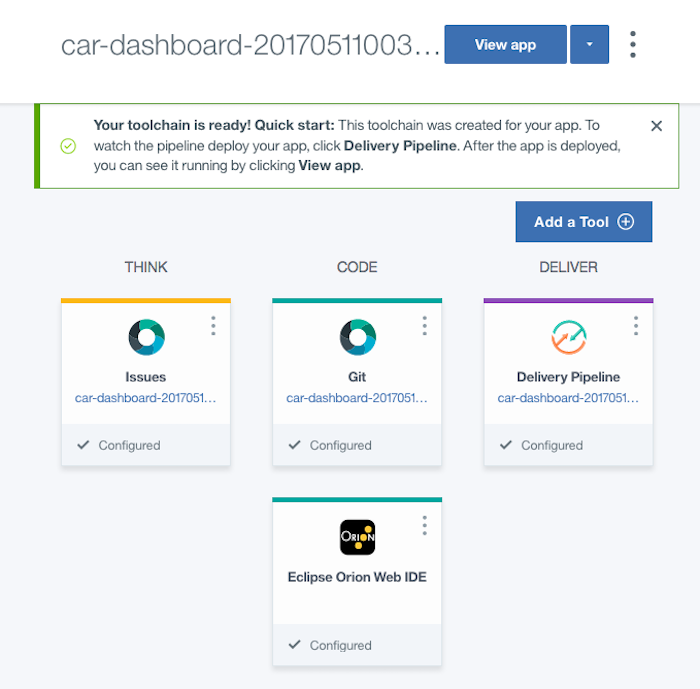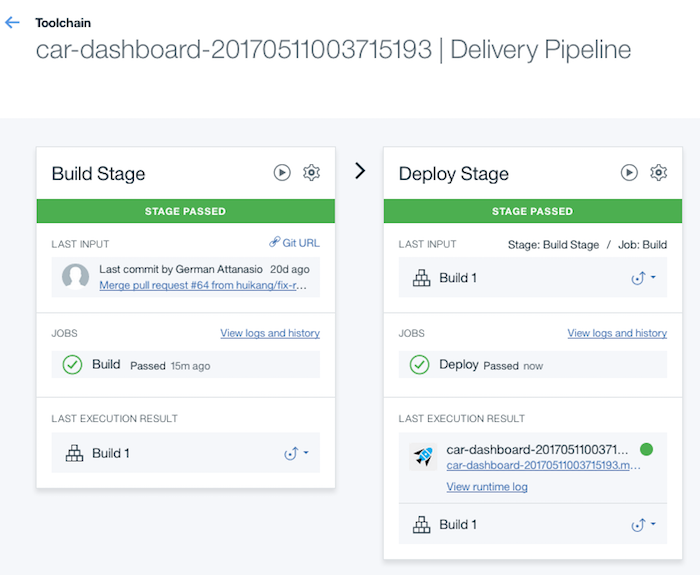This application demonstrates how the Watson Assistant service uses intent capabilities in an animated car dashboard UI.
For more information about Watson Assistant, see the detailed documentation.
The app interface is designed and trained for chatting with a cognitive car. The interface allows the user to enter input either using text, in the edit field at the bottom of the UI or via speech via by pressing the mic button. Your questions and commands are run against a small set of sample data trained with intents like these:
turn_onweathercapabilities
These intents help the system to understand variations of questions and commands that you might submit. For example, if you say "Wipers on" or "I want to turn on the windshield wipers", the system understands that in both cases your intent is the same and responds accordingly.
1 Ensure that you have an IBM Cloud account.
2 Ensure that you have the necessary space available in your IBM Cloud account. This action deploys 1 application and 3 services.
- You can view this on your IBM Cloud Dashboard. Tiles will show what space you have available.
- For example, for Services & APIS
1 Click this button to Deploy to IBM Cloud.
2 Log in with an existing IBM Cloud account or sign up.
3 Select your Organization, Toolchain Name, Region, and Space, then click theDeploybuton.
-
This performs multiple actions:
- Creates the app
- Creates a Watson Assistant service instance that the user needs for workspace creation
- Creates instances for a Speech To Text service and Text To Speech service
-
Your
car-dashboardapp is ready now, clickDelevery Pipelineto deploy your app.
5 Once your app has been built and deployed, navagate to your IBM Cloud Dashboard and import a workspace.
To build the application:
1 Download and install the Cloudfoundry CLI tool.
2 Git clone the project https://github.com/watson-developer-cloud/car-dashboard
3 Navigate to the car-dashboard folder
4 Connect to IBM Cloud in the command-line tool:
For US Region
$ cf api https://api.ng.bluemix.net
$ cf login -u <your user ID>
5 Create the Watson Assistant service in IBM Cloud (our CLI is being updated, for now, use the create-service conversation command):
$ cf create-service conversation free watson-assistant-service
6 Push it live:
$ cf push <application-name>
The name you use determinates your application URL initially, such as <application-name>.mybluemix.net.
1 Ensure that you have an IBM Cloud account. While you can do part of this deployment locally, you must still use Bluemix.
2 In IBM Cloud, create a Watson Assistant Service.
- Copy the Service Credentials for later use.
- Import a workspace
3 OPTIONAL: If you want to use Text To Speech and/or Speech To Text in your locally runnning app, create a text-to-speech service and/or a speech-to-text service like you did in step 2.
- Copy the Service Credentials for later use.
The application uses Node.js and npm.
1 Copy the credentials from your watson-assistant-service service in IBM Cloud to a .env file in the root.
- Look at
.env.exampleas an example to create your.envfile.
2 OPTIONAL: If you want to use Text To Speech and/or Speech To Text in your locally runnning app, copy the credentials from your text-to-speech service and/or speech-to-text service in IBM Cloud to a .env file in the root.
- Look at
.env.exampleas an example to add to your.envfile.
3 Use the Watson Assistant tooling app to create a workspace, as described above, and add the workspace ID environment variable to the .env file. For details about obtaining the workspace ID, see Step 6 - 7 in the next section.
4 Install Node.js.
5 Open the terminal, go to the project folder, and run this command:
npm install
6 Build the UI by running this command:
npm run build
7 Start the application by running this command:
npm start
8 Open http://localhost:3000 in a browser.
Note: If you are interested in deploying you local application or the changes you have made locally to IBM Cloud, go to this section
1 You need to import the app's workspace. To do that, go to the IBM Cloud Dashboard and select the Watson Assistant service instance. Once there, select the Service Credentials menu item.
2 Select ADD CREDENTIALS. Name your credentials then select ADD.
3 Return to the Manage menu item and select Launch Tooling. This opens a new tab in your browser, where you are prompted to login if you have not done so before. Use your IBM Cloud credentials.
4 Download the exported JSON file that contains the Workspace contents.
5 Goto Skills tab. Click on Create Skill. The Dialog skill is the default selection. Click on Next button at the bottom of the page. On the next page select Import skill tab. The Everything(Intents, Entities, and Dialog) option is preselected. Select Choose JSON file button and local the car_workspace.json file.
6 Refresh your browser. A new workspace tile is created within the tooling. Select the menu button within the workspace tile, then select View details:
In the Details UI, copy the 36 character UNID **ID** field. This is the **Workspace ID**.7 Return to your application, either in your local dev environment, or in IBM Cloud. If running on IBM Cloud, you need to add environment variables.
For more information on workspaces, see the full Watson Assistant service documentation.
1 In IBM Cloud, open the application from the Dashboard. Select RUNTIME on the left side menu.
2 Select ENVIRONMENT VARIABLES and scroll down to USER-DEFINED.
3 Select ADD.
4 Add a variable with the name WORKSPACE_ID. For the value, paste in the Workspace ID you copied earlier. Select SAVE.
5 Add a variable with the name NAMESPACE. For the value, type bx wsk action get translator namespace on terminal to get the namespace id. Select SAVE.
6 Restart your application.
- Log in to IBM Cloud, you'll be taken to the dashboard.
- Navigate to the the application you previously created.
- Select Logs.
- If you want, filter the LOG TYPE by "APP".
- Log in to IBM Cloud, you'll be taken to the dashboard.
- Select Compute
- Select the application you previously created.
- Select Logs.
- If you want, filter the Log Type by selecting the drop-down and selecting Application(APP).
$ cf logs < application-name > --recent
This sample code is licensed under Apache 2.0. Full license text is available in LICENSE.
See CONTRIBUTING.
Find more open source projects on the IBM Github Page.







